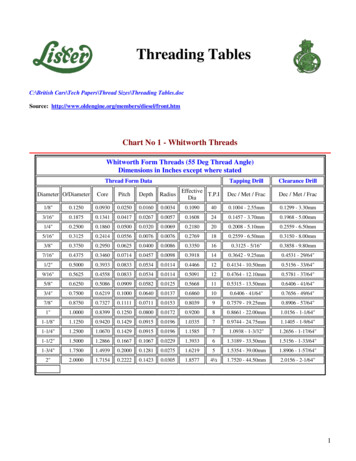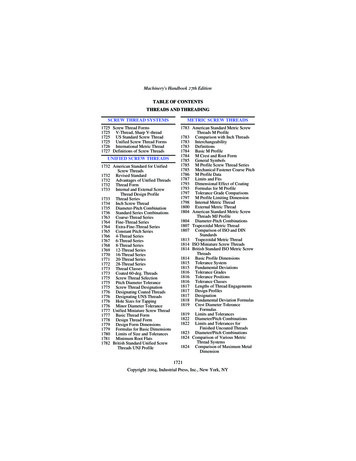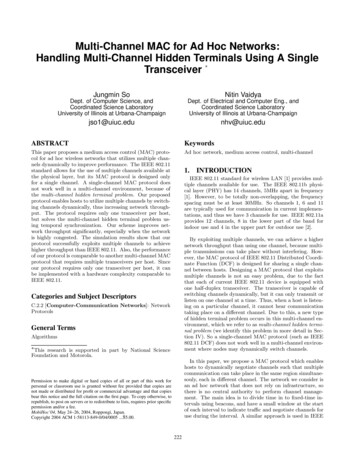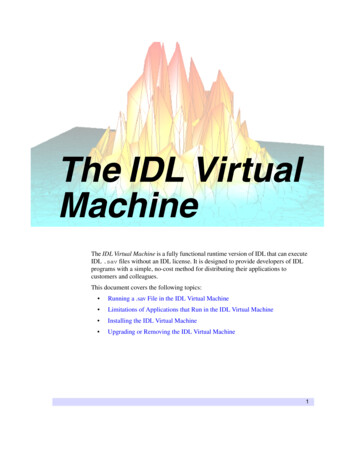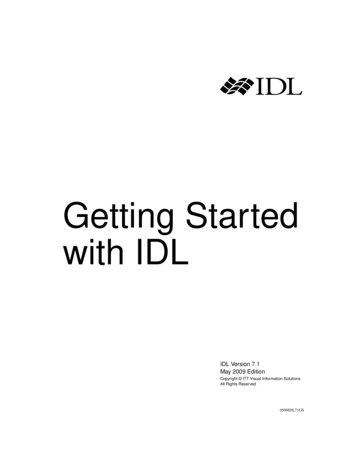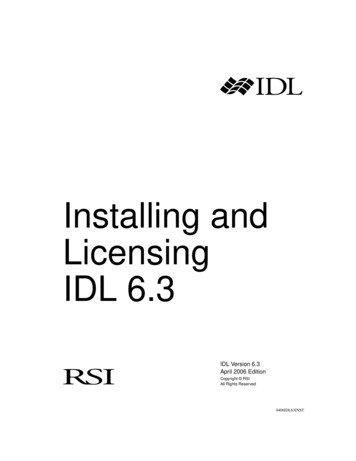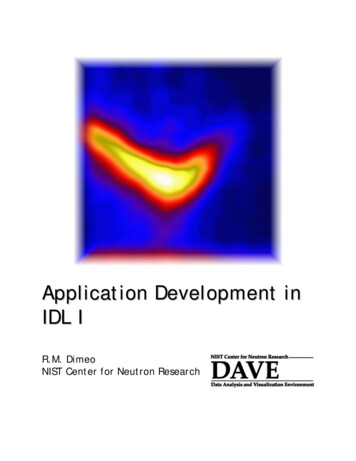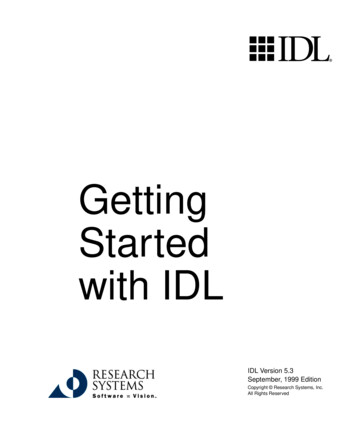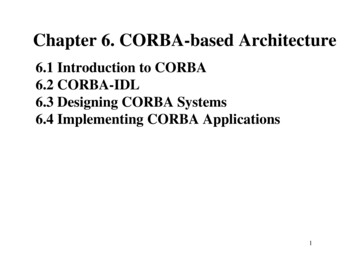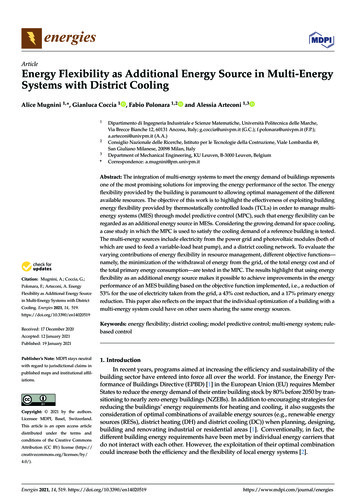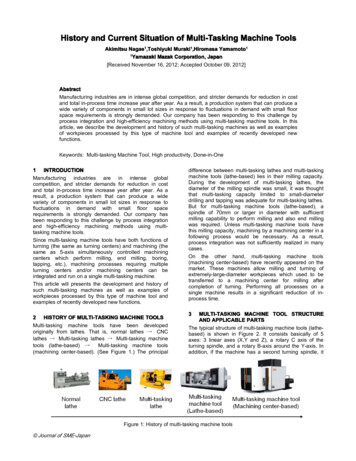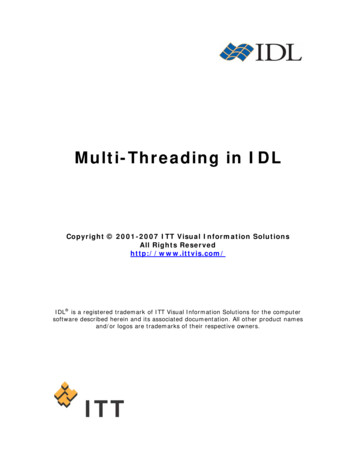
Transcription
Multi-Threading in IDLCopyright 2001-2007 ITT Visual Information SolutionsAll Rights Reservedhttp://www.ittvis.com/IDL is a registered trademark of ITT Visual Information Solutions for the computersoftware described herein and its associated documentation. All other product namesand/or logos are trademarks of their respective owners.
Multi-Threading in IDLTable of ContentsI. IntroductionIntroduction to Multi-Threading in IDLWhat is Multi-Threading?Why Apply Multi-Threading to IDL?A Related Concept: Distributed ProcessingII. The Thread PoolDesign and Implementation of the Thread PoolThe IDL Thread PoolWhy The Thread Pool Beats AlternativesRe-Architecture of IDLAutomatically Parallelizing CompilersThreading at the User LevelIII. Performance of the Thread PoolYour Mileage May VaryAmdahl’s LawInterpreting TIME THREAD PlotsExample System ResultsPlatform ComparisonsIV. ConclusionsSummaryAdvice (So What Should I Buy?)V. AppendicesAppendix A: IDL Routines that use the Thread PoolAppendix B: Additional Benchmark ResultsAppendix C: GlossaryITT Visual Information Solutions 4990 Pearl East Circle Boulder, CO 80301P: 303.786.9900 F: 303.786.9909 www.ittvis.comPage 2 of 543335577799101113131315173136363739394153
Multi-Threading in IDLIntroductionIntroduction to Multi-Threading in IDLITT-VIS has added support for using threads internally in IDL to accelerate specificnumerical computations on multi-processor systems. Multi-processor capablehardware has finally become cheap and widely available. Most operating systemshave support for SMP (Symmetric Multi-Processing), and IDL users are beginning toown such hardware. In the future, it is reasonable to imagine that most machineswill have multiple CPUs.The multi-threading capability, first added in IDL 5.5, applies to binary and unaryoperators, many core mathematical functions, and a number of image processing,array manipulation and type conversion routines. Although performance results willvary, the execution time of these computations can be significantly reduced onsystems with multiple processors. The ability to exploit multiple CPUs will becomevery important in coming years, and the list of threaded routines is expected to growwith each release of IDL.IDL users should be aware that ITT-VIS offers a Global Services Group (GSG) thatcan be hired to help optimize user-written code or to parallelize specific algorithmsbeyond those that use the thread pool.The interface for controlling the IDL thread pool is simple, allowing immediate andmeasurable benefits with little effort. In addition, the IDL thread pool is safe andtransparent on platforms that are unable to support threading. Those platforms thatcan benefit will use threads, and those that cannot will continue to produce correctresults using a single thread, and with the same level of performance as previousversions of IDL.This chapter provides background and motivation for IDL’s multi-threadingcapability.What is Multi-Threading?The concept of multi-threading involves an operating system that is multi-threadcapable allowing programs to split tasks between multiple execution threads. On amachine with multiple processors, these threads can execute concurrently,potentially speeding up the task significantly. Mathematical computations on largeamounts of scientific data can be quite intensive and are ideal candidates forthreading on systems with multiple CPUs.ITT Visual Information Solutions 4990 Pearl East Circle Boulder, CO 80301P: 303.786.9900 F: 303.786.9909 www.ittvis.comPage 3 of 54
Multi-Threading in IDLThe most common type of program is the single-threaded program. IDL hastraditionally been single-threaded. When the program runs, this single thread startsat the main() function in the program, and runs until it either exits, or performs anillegal operation and is killed by the operating system. Since it is the only thread, itknows that anything that happens in this program is caused solely by it. Mostmodern operating systems time slice between various programs, so at any giventime, a single thread is either running or sleeping. There are two reasons why it maybe sleeping: It is waiting for a needed, but currently unavailable resource (e.g. memory,data (input, output).). The operating system is letting some other program run.This time slicing, which is usually preemptive multitasking, happens so quickly thatthe end user is fooled into thinking that everything is running simultaneously.To move from single-threaded to multi-threaded (MT) programs requires a smallconceptual generalization of the above. Instead of having only a single thread, weallow more than one thread in a single process. Each thread has its own programcounter and stack, and is free to run, unimpeded by any other thread in the sameprogram. All threads in the same program share any other resources, including code,data, and open files. The operating system still schedules which threads run andwhen, but instead of scheduling by process, it now schedules the individual threadswithin a process. If your system has a single CPU, preemptive multitasking still givesthe illusion that more than one thing is going on simultaneously. If the system hasmore than one CPU, then more than one thread can be running on the system at agiven time. It is even possible that more than one thread within a given program willrun simultaneously. This is actual simultaneous execution, not the mere illusion of itas with a uniprocessor.It is important to realize that the software concept of threading is an abstractionprovided by the operating system, and it is available whether or not the underlyinghardware has multi-processing (MP) capabilities. It is reasonable to run a MTprogram on a uniprocessor, unless your program requires actual simultaneousexecution of multiple threads to work properly. For example, a program might use athread to wait for incoming data from a slow source, while other threads manage theuser interface and perform other tasks. Multi-processor hardware is not necessaryfor such a program. In contrast, if you are using threads to speed up a numericalcomputation, you will require actual MP hardware to see any benefit. On auniprocessor, this program will work harder (MT code adds overhead) and will takeessentially the same amount of time to complete as a single-threaded version.Common sense suggests that threading does not make a uniprocessor able tocompute any faster.ITT Visual Information Solutions 4990 Pearl East Circle Boulder, CO 80301P: 303.786.9900 F: 303.786.9909 www.ittvis.comPage 4 of 54
Multi-Threading in IDLWhy Apply Multi-Threading to IDL?Simply put, ITT-VIS has implemented multi-threading in IDL in order to allow usersto harness additional CPUs to do more work in less time. Scientific data sets continueto grow in size faster than computers can process them. Multi-processors offer oneway to handle larger problems.Multi-processor hardware and Symmetric Multi-Processing (SMP) have become cheapand easily available. There are some powerful trends driving this change:1. As transistor densities on processor chips increase with each generation,there is room for replicated processing units.2. At any given point in time, the cost of the second most powerful CPU inproduction is much lower than the most powerful CPU. It makes sense that ifyou can harness multiple cheap, but only slightly less powerful, CPUs, you cando more work for less money.3. There are physical limits that govern how fast a single CPU can possibly go,and we expect to hit those limits within a few (10-20, max) years. Once wehit this limit, the only way to increase computing power may be to add CPUs.The development of SMP systems has been driven not by the need to run multithreaded programs, but by a need to increase throughput on servers that runmultiple single-threaded programs simultaneously (e.g., to serve files, mail andprinting). Economies of scale allow computer vendors to apply this technology todesktop machines. It is becoming common for individuals to have such machines,and it appears that this trend will continue.A Related Concept: Distributed ProcessingMulti-threading is not the same distributed processing. While distributed processing,sometimes called parallel processing, and multi-threading are both techniques forachieving parallelism (and can be used in combination), they are fundamentallydifferent. Multi-threading attacks the problem of doing more work faster at the microlevel, while distributed processing attacks this at the macro level.Multi-threading is a way to let programs do more than one thing at a time,implemented within a single program, and running on a single system. Multithreading requires special support from the implementation language (or its supportlibraries) and the underlying operating system. Over the last 20 years, research inthis area has matured to the point where stable, reasonably portable, systeminterfaces exist for writing threaded programs. Standardization of these interfacesensures that we can use them knowing that they will have a long life and provide astable basis for our work.ITT Visual Information Solutions 4990 Pearl East Circle Boulder, CO 80301P: 303.786.9900 F: 303.786.9909 www.ittvis.comPage 5 of 54
Multi-Threading in IDLDistributed processing is a way for multiple programs, usually running on differentsystems connected over a fast local network, to cooperate in solving a single, usuallylarge, problem. Distributed processing does not usually require any special languageor OS support, but it requires a support framework (usually in a library that theprograms can link to) that oversees the process of managing the communication oftasks to end nodes, the communication between them, and the pulling together ofthe final results. At this time, there are several different approaches to solving thesesorts of problems, and standardization has not yet occurred. There are, however,some clear favorites, such as PVM (Parallel Virtual Machine) and MPI (MessagePassing Interface).Distributed processing does not require direct internal support within IDL. Thecurrent implementation of IDL is not preventing its use within a parallel processingframework. In fact, IDL users have already had success with distributed processingwith IDL by taking advantage of larger existing frameworks such as PVM or MPI.An example of software technology that provides a cluster (distributed) computingsolution for IDL is the FastDL product available from Tech-X ITT Visual Information Solutions 4990 Pearl East Circle Boulder, CO 80301P: 303.786.9900 F: 303.786.9909 www.ittvis.comPage 6 of 54
Multi-Threading in IDLThe Thread PoolDesign and Implementation of the Thread PoolStarting with version 5.5, IDL has the ability to use a thread pool to divide numericalcomputations among multiple CPUs. This multi-threading capability applies toarithmetic operators and mathematical functions, along with many image processing,array manipulation, and type conversion routines. Users can control the IDL threadpool to their advantage, through a simple interface that allows immediate andmeasurable benefits with very little effort.ITT-VIS carefully considered other implementation options and chose the thread poolfor a number of reasons. The IDL thread pool is a convenient implementation thatallows IDL users to take advantage of multiple processors to speed numericalcomputations today--without having to wait for ITT-VIS to complete a resourceintensive and time-consuming re-architecture of IDL. With the design of the IDLthread pool, IDL maintains its single-threaded organization and uses threads only infocused and tightly controlled ways that will not lead to statistical bugs, lockingproblems, or other threading pitfalls.This chapter discusses the design of the IDL thread pool and explains why theimplementation beats the alternatives.The IDL Thread PoolThe IDL thread pool provides a robust and simple mechanism for overlappingnumerical computations to achieve potentially significant performance gains. Itconsists of a group of threads (excluding the main thread) that are created when IDLstarts. On a system that supports N CPUs, the thread pool default is to have N-1threads in the pool. Counting the main thread, this gives you one thread for eachprocessor. While the thread pool sleeps, the main thread runs IDL much as it alwayshas, as a single threaded application. When not involved in a calculation, the threadsin the thread pool are inactive and consume little in the way of system resources.When IDL reaches a computation that can use the thread pool and which can benefitfrom parallel execution, the main thread assigns the N-1 threads of the thread poolwork to do, and wakes them to run in parallel with the main thread. Once the helperthreads finish their tasks and go back to sleep, the main thread continues. To theuser, this looks and feels like a single threaded application that simply seems to runfaster.The initial use of the IDL thread pool has been to thread IDL's array-orientedarithmetic operators and mathematical functions, along with many image processing,ITT Visual Information Solutions 4990 Pearl East Circle Boulder, CO 80301P: 303.786.9900 F: 303.786.9909 www.ittvis.comPage 7 of 54
Multi-Threading in IDLarray manipulation, and type conversion routines. The IDL thread pool has also beenused to replace the existing implementation of multi-threading for volume rendering.For a complete listing of threaded routines, see the IDL Reference Guide.The IDL thread pool is easy to use, providing an immediate and measurable benefitto the IDL user without requiring a special effort. IDL automatically determines whenand how to employ multi-threading. When IDL encounters eligible computations, itdetermines whether or not to use the IDL thread pool to carry them out. This isbased on the availability of multiple CPUs in the current system as well as on thenumber of data elements in the input array. The latter criterion is somewhatheuristic because IDL cannot know all of the information necessary to determine theeffect multi-threading will have on performance. If a computation involves too fewelements, the overhead involved in splitting a problem between threads may exceedthe gain. If a computation involves too many elements for the system memory, thevirtual memory system will be activated (paging), and threads may begin competingfor access to memory. Both situations could result in poorer, not better, performancerelative to the single-threaded alternative. Using the number of elements in the inputarray as a factor in deciding whether to employ the thread pool in a givencomputation is a good rule of thumb. As with all rules of thumb, there are situationsin which it applies less well. There are also other reasons threading may not bedesired. For instance, out of courtesy to other users on a multi-user system, or whenthe rounding of finite precision floating point types may produce different (althoughequally correct) results in algorithms that are sensitive to the order of operations.For all of these reasons, the IDL user is provided with a simple interface to controlthe parameters IDL uses when deciding to employ multi-threading: A read-only system variable named !CPU that reflects the current state ofIDL's use of processor features. !CPU is initialized by IDL at startup withdefault values for the number of CPUs (threads) to use, as well as theminimum and maximum number of data elements. If you have more than oneprocessor on your system, if your desired computation is able to use the IDLthread pool, and if the number of data elements in your computation falls intothe allowed range (neither too few, nor too many), then IDL will employ thethread pool in that calculation. A system procedure named CPU which is used to alter the state of !CPU. Withthe CPU procedure, the user can control the minimum and maximum numberof data elements for which IDL will use the thread pool, and the number ofthreads to use. Standard thread pool keywords accepted by all system routines that use theIDL thread pool. These keywords are used to override the defaults establishedby !CPU on a per-call basis.The IDL thread pool is safe and transparent on platforms that are unable to supportthreading. Those platforms that can benefit will use threads, and those that cannotwill continue to produce correct results using a single thread, and with the samelevel of performance as previous versions of IDL.ITT Visual Information Solutions 4990 Pearl East Circle Boulder, CO 80301P: 303.786.9900 F: 303.786.9909 www.ittvis.comPage 8 of 54
Multi-Threading in IDLWhy The Thread Pool Beats AlternativesThe IDL thread pool is a convenient way to apply multiple threads without rearchitecting IDL’s language and interpreter. It can potentially be applied, internally,to any task that does not call a non-reentrant function. While this limits the scope ofpossibilities, numerical computations fit this requirement well. Many IDL users aregrappling with ever-growing data and can benefit from the ability to solve largerproblems faster with multi-processors.To enable the users of IDL to take advantage of powerful MP hardware in solvinglarge computational problems, ITT-VIS had several options. IDL could have beencompletely re-architected to make the language and interpreter reentrant andthread-safe. Perhaps an auto-parallelizing compiler could have been employed toease this task. Threads could have been exposed at the user level, instead ofinternally. ITT-VIS considered these options carefully and chose the IDL thread poolimplementation for a number of reasons.Re-Architecture of IDLSince its inception more than twenty years ago, IDL has existed as a single-threadedprogram. The implementation of the IDL thread pool does not change this fact. Withthe thread pool implementation, IDL’s internal use of threads is well-contained,allowing IDL to maintain its single-threaded organization. Retrofitting a singlethreaded program to use threads is a resource-intensive endeavor, and the endresult is likely to be error-prone and may suffer poorer performance overall.Developers who take on the task face the following challenges: In a MT program, there can be more than one thread of executionsimultaneously running within the same program and address space.Programs use this to produce all sorts of desirable effects. On the negativeside, in a MT program, a given thread cannot assume that it is the only causeof change within the program. Threads must be careful not to change data attimes when other threads are accessing it, or problems that are unpredictableand difficult to fix will result. Single-threaded code usually makes many implicit assumptions that simply donot hold in threaded code. Single-threaded code is rarely designed to bereentrant or with careful thought to how locking might be used to controlaccess to critical sections. (Locking keeps multiple threads from colliding.) Itis easy to understand why the authors of single-threaded code may notaddress these issues, as the solutions usually require additional time todesign and implement, and often require some sacrifice in simplicity orperformance.ITT Visual Information Solutions 4990 Pearl East Circle Boulder, CO 80301P: 303.786.9900 F: 303.786.9909 www.ittvis.comPage 9 of 54
Multi-Threading in IDL UNIX programs of any complexity usually need to handle signals. In a singlethreaded program, signals are delivered to the program as they occur. Aprocess has a signal mask that controls if it is able to receive a given signal.Signals not currently allowed are quietly remembered by the system, and willbe delivered if the signal mask should change to allow it. In a multi-threadedprogram, the situation is predictably more complex. Each thread has its ownsignal mask. Synchronous signals (such as division by zero) are al
some clear favorites, such as PVM (Parallel Virtual Machine) and MPI (Message Passing Interface). Distributed processing does not require direct internal support within IDL. The current implementation of IDL is not preventing its use within a parallel processing framework. In fact, IDL u
